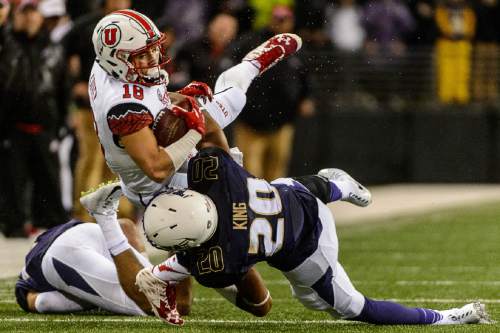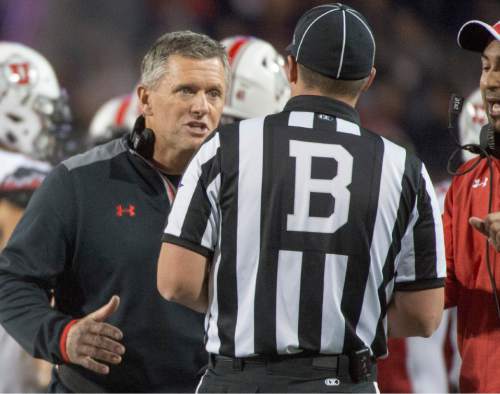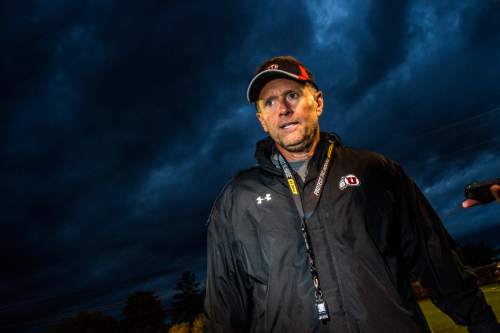This is an archived article that was published on sltrib.com in 2015, and information in the article may be outdated. It is provided only for personal research purposes and may not be reprinted.
"How did it get so late so soon? It's night before it's afternoon. December is here before it's June. My goodness how the time has flewn. How did it get so late so soon?" - Dr. Seuss
Two things were accomplished with that verse: 1) It describes the feeling we all experience at this juncture of the football season and 2) I always wanted to start a column with a bit of brilliance from Dr. Seuss. It was either that or "Sometimes the questions are complicated and the answers are simple."
For Utah, the regular season ends Saturday … and with it comes complicated questions about the past and the future, and answers that don't seem so simple.
If the Utes beat last-place Colorado at Rice-Eccles Stadium, they will have achieved their best Pac-12 record ever, at 6-3. As Kyle Whittingham has said a couple of times this week, there's been progression in the program in 2015.
It's just that a lot of that progress was buried in the rubble of unfulfilled expectation. A month or so ago, the Utes, to the surprise of everybody, were undefeated and ranked No. 3 in the country, staring down the pipe at a possible spot in the college football playoff or, at minimum, the Rose Bowl. Now, after three losses, they could end up anywhere from the Cactus Bowl to the Vegas Bowl to the Holiday Bowl, or, worst case, with a fourth loss, they could be shut out of the Pac-12's seven affiliated bowls.
Even with their late slide, the Utes probably will end up with their top performance as a member of the Pac-12, despite having limped home with knockout injuries to their best overall player, Devontae Booker, their best running back, Booker, and their best playmaking receiver, Britain Covey. The defense also suffered from depleted ranks, but that side of the ball was seldom the problem this season.
It was the other side. Utah will finish second-to-last in passing offense, second-to-last in overall offense, ninth in scoring offense, and 10th in first downs. A year ago, it had similar results. Einstein, you don't have to be to see what has to change for the Utes to take a step up: pass offense. Specifically, the wide receivers need to improve and the quarterback has to play better.
In 2015, the top passing targets were a freshman, Covey, who had 41 catches for 518 yards, and a running back, Booker, who had 37 catches for 318. Both are out for Saturday's finale and neither will be here next year.
Travis Wilson ranks 10th among QBs in the league in passing yards, throwing for 191 per game. In total, he's got 1,916 yards, which is substantially less than half of what league-leader Luke Falk has. Falk's thrown for 36 touchdowns; Wilson has 12.
No Ute receiver ranks among the top 12 in receptions or yards. In either of those groups, Washington State has three receivers, Arizona State has three, UCLA has two, Oregon has one and USC has one, among others.
It's noted that Utah had a run-heavy attack, and the reasoning behind that, beyond having one of the league's premier running backs, is one of two things: Either the Utes didn't throw the ball effectively or proficiently because they didn't have the players capable of doing so, or they didn't throw the ball effectively or proficiently because the coaches chose not to.
But it's come clear that in the fog of battle in the Pac-12, having a threat at quarterback is more a necessity than it is a luxury and having receivers who can get open at the back end of defenses falls into the same category.
Although Whittingham wouldn't get specific regarding at whose feet the blame should be dropped for that failing, he must know in his heart and in his head that it's too hard to compete in this conference without a full complement of offensive weaponry — and an emphasis on the part of coaches and coordinators to use it. Look around the Pac-12 at the receivers capable of making big plays, and it's easy to add up the disadvantage there for the Utes.
It is the biggest obstacle, the greatest weakness Utah faces in further ascension toward the top, one that must be solved for the progress to continue. Recruiting is the key, alongside alterations in offensive design.
After the UCLA loss, Whittingham on Monday said this: "It really came down to a couple things, 1) our inability to get much going in the throwing game. We had 110 yards, which, uh, is not enough. … And not being able to score touchdowns in the red zone.
"We just couldn't get any separation. It's hard to throw the ball, to find somewhere to go with it when nobody's open. That was the situation on Saturday and it's been the situation a few times this year. We're getting bogged down in the throwing game because we have a hard time separating."
Fixing that, like the doctor wrote it, is complicated and it's simple.
At present, though, it's more of the former than the latter — until athletes, on the throwing and catching ends, can be found capable of changing it, prompting coaches to allow them to do so.
GORDON MONSON hosts "The Big Show" with Spence Checketts weekdays from 3-7 p.m. on 97.5 FM and 1280 AM The Zone. Twitter: @GordonMonson.











